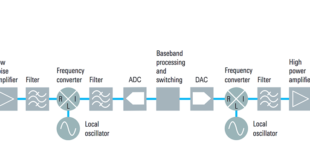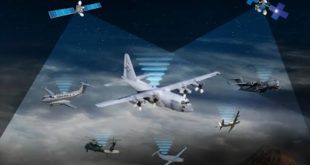The “New Space” era is characterized by the rapid proliferation of Low Earth Orbit (LEO) satellite constellations designed to provide global internet coverage, enhance remote sensing capabilities, and facilitate communications. These constellations, consisting of hundreds to thousands of small satellites, orbit much closer to Earth than traditional geostationary satellites, offering lower latency and higher data rates. However, the unique characteristics of LEO satellites, such as their rapid movement and short visibility windows, pose significant challenges for ground station antennas. Traditional antennas, designed for a bygone era of fewer, geostationary satellites, simply can’t keep pace with the dynamic nature of these new constellations. Innovations in ground station antenna technology are crucial to overcoming these challenges and fully realizing the potential of the “New Space” revolution.
The role of satellite communication in the 5G era and beyond is transformative. It complements terrestrial networks by providing ubiquitous coverage, broadcast/multicast services, aeronautical and maritime communications, emergency/disaster recovery solutions, and connectivity in remote rural areas. The rapid pace of technological change in the “New Space” revolution demands innovations in ground station infrastructure to keep up with the advancements in satellite technology. But this revolution hinges on a critical, yet often overlooked, component: ground stations. These stations act as the Earth-bound counterparts, communicating with the orbiting satellites. Here’s where ground station antenna innovations step in, ensuring efficient and reliable data flow for the New Space revolution.
Key Challenges in LEO Satellite Ground Communications
Low Earth Orbit (LEO) satellite constellations, positioned within the range of 300 to 3000 kilometers above Earth’s surface, present a unique set of challenges stemming from their proximity to our planet. These satellites boast lower propagation delays and losses, along with higher Doppler shifts compared to their Geostationary Earth Orbit (GEO) counterparts. Consequently, robust transmitter-receiver architectures capable of mitigating Doppler effects become imperative for the seamless operation of LEO deployments. However, the dynamic nature of LEO orbits, characterized by orbital velocities of up to 7.8 kilometers per second and orbital periods as short as 100 minutes, poses significant obstacles. This rapid motion results in brief visibility windows for ground stations, typically spanning only 15 to 20 minutes, necessitating swift and precise data acquisition strategies for remote sensing satellites.
- Rapid Satellite Movement: LEO satellites travel at speeds of around 7.8 km/s, leading to frequent handovers between ground stations.
- Short Visibility Windows: Each satellite is only visible to a ground station for about 10 to 20 minutes per pass.
- High Doppler Shift: The relative velocity between the satellite and ground station causes significant Doppler shifts, affecting signal frequency and quality.
- Frequent Handoffs: The need for continuous connectivity requires seamless handovers between ground stations and antennas.
This shift from geostationary (GEO) satellites to low Earth orbit (LEO) and medium Earth orbit (MEO) satellites introduces new challenges that require state-of-the-art solutions.
Traditional ground station antennas were designed for a bygone era of fewer, geostationary satellites. The challenges of the New Space era are vastly different:
- Sheer Numbers: LEO constellations involve hundreds, even thousands, of satellites whizzing across the sky at high speeds. Tracking and communicating with them demands agility and flexibility.
- Rapid Data Exchange: The constellations aim to provide high-bandwidth services like internet access. Ground station antennas need to handle this data deluge efficiently.
- Cost Constraints: New Space companies often operate with lean budgets. Ground station solutions need to be cost-effective and scalable.
The satellite communications industry, however, is dominated by dish antennas mounted on motorized gimbals for these applications. These solutions are too large, heavy, and power-consuming to offer solutions for consumer mobile applications such as the connected car or a personal satellite terminal.
Innovations in Ground Station Antenna Technology
1. Phased Array Antennas
Phased array antennas represent a significant advancement in ground station technology. Unlike traditional parabolic dish antennas, which physically move to track satellites, phased array antennas electronically steer their beams. This capability allows for rapid and precise tracking of multiple LEO satellites simultaneously.
A phased array antenna is a collection of antenna elements assembled together such that the power from the transmitter is fed to the antennas through devices called phase shifters, controlled by a computer system, which can alter the phase electronically, thus steering the beam of radio waves to a different direction. The result is that each antenna in the array has an independent phase and amplitude setting to form the desired radiation pattern. This phase shift will introduce interference between the signals transmitted.
The radio frequency current from the transmitter is fed to the individual antennas with the correct phase relationship so that the radio waves from the separate antennas add together to increase the radiation in a desired direction, while cancelling to suppress radiation in undesired directions. The direction of radiation can be manipulated by changing the phase of the signal fed into each antenna element.
Advantages:
- High Tracking Speed: Electronic beam steering eliminates the mechanical inertia of traditional antennas, allowing for instant adjustments.
- Multi-Satellite Tracking: Phased arrays can track multiple satellites at once, essential for dense LEO constellations.
- Improved Reliability: With no moving parts, phased arrays are more durable and require less maintenance.
Reflector Antennas with Electronically Steerable Feeds: These antennas utilize a traditional parabolic dish for signal strength, but with an electronically controlled feed that directs the beam. This offers a balance between affordability and flexibility. Think of a satellite dish with a movable “eye” at its focal point.
2. Flat Panel Antennas
Flat panel antennas, such as those using metamaterials or electronically scanned arrays (ESAs), offer a compact and scalable solution for LEO satellite communications. These antennas are lightweight and can be easily installed on various platforms, from rooftops to mobile units.
Many different approaches can be taken to develop next-generation flat-panel antennas. All consist of small antennas, known as radiating elements, and both receive- and transmit-side amplification. A passive antenna takes one signal from the power amplifier (PA) on the transmit side and divides this signal out to the transmit radiating elements, then combines the receive signals from the radiating elements before feeding the receive-side low-noise amplifier (LNA). An active antenna, in contrast, has a single amplifier per radiating element, for both transmit (TX) and receive (RX). In general, passive antennas are less complex, while active antennas provide greater gain performance.
Advantages:
- Portability and Flexibility: Their compact form factor makes them suitable for a wide range of applications, including mobile and maritime communications.
- Cost-Effective Deployment: Flat panel antennas are easier and cheaper to deploy than traditional large dish antennas.
- High Gain and Efficiency: Despite their small size, these antennas can achieve high gain and efficiency, crucial for maintaining strong signals with fast-moving satellites.
3. Adaptive Beamforming
Adaptive beamforming technology enhances the performance of ground station antennas by dynamically adjusting the direction and shape of the antenna beam to maximize signal quality. This technology is particularly useful in mitigating the effects of Doppler shifts and other signal disturbances.
-
Advanced Beamforming Techniques:
- Massive MIMO (Multiple-Input and Multiple-Output): This technology utilizes a multitude of antenna elements to create highly focused beams, allowing communication with multiple satellites simultaneously. Imagine a single antenna acting like a multi-beam spotlight, efficiently communicating with several satellites in its field of view.
- Digital Beamforming: By electronically manipulating the signals from each antenna element, ground stations can precisely steer the beam to track fast-moving LEO satellites and mitigate interference from nearby objects. Think of a traditional antenna dish with a “smart” feed that can dynamically adjust its focus.
- Advantages:
- Enhanced Signal Quality: By continuously optimizing the beam pattern, adaptive beamforming ensures optimal signal reception.
- Doppler Shift Mitigation: The technology can adapt to rapid changes in signal frequency caused by the Doppler effect.
- Interference Reduction: Adaptive beamforming can also minimize interference from other signals, improving overall communication reliability.
4. Reconfigurable Antennas:
These antennas can adapt their physical structure or electrical properties on demand. This allows them to:
- Optimize Performance for Different Frequencies: Reconfigurable antennas can adjust to different frequency bands used by various LEO constellations, maximizing efficiency and ensuring seamless communication.
- Reduce Costs: A single reconfigurable antenna can potentially handle multiple constellations operating on different frequencies, eliminating the need for dedicated antennas for each band. Imagine a single antenna that can morph to best suit the needs of different satellites.
5. Software-Defined Antennas
Software-defined antennas (SDAs) leverage advanced software algorithms to control antenna behavior. This flexibility allows for real-time reconfiguration of the antenna system to adapt to changing satellite positions and communication requirements.
They separate the antenna hardware from the control software, allowing for:
- Remote Configuration and Management: Ground station operators can configure and manage antenna settings remotely, improving operational flexibility and reducing maintenance costs.
- Real-time Optimization: The software can analyze data and adjust antenna parameters in real-time to optimize performance based on current satellite positions and network conditions.
Advantages:
- Real-Time Adaptability: SDAs can quickly adapt to new satellite positions and frequencies without hardware changes.
- Scalability: The software-based approach allows for easy scaling of antenna networks to support larger satellite constellations.
- Integration with Network Management: SDAs can be integrated with network management systems for automated control and optimization.
6. Optical Ground Stations
While still in the experimental stage, optical ground stations represent a future-forward approach to satellite communications. These stations use laser-based communication, which offers higher data rates and greater security compared to traditional RF-based systems.
Advantages:
- High Data Rates: Optical communications can achieve data rates much higher than RF systems, supporting the increasing demand for bandwidth.
- Low Interference: Optical systems are less prone to interference, providing more reliable communication links.
- Enhanced Security: The narrow beams of laser communications are harder to intercept, enhancing data security.
6. Metamaterial Integration:
Metamaterials, engineered materials with unique electromagnetic properties, are finding their way into ground station antennas. These metamaterials can:
- Enhance Beam Steering Capabilities: Metamaterial-based structures can manipulate radio waves in innovative ways, enabling even more precise beam steering and improved tracking performance for LEO constellations.
- Reduce Antenna Size: Metamaterials can achieve similar performance to traditional bulky antennas in a smaller form factor. This is crucial for deploying ground stations in space-constrained environments.
Innovation extends beyond antenna design to encompass operational efficiency:
- Multi-Satellite Communication: Utilizing advanced signal processing techniques, ground stations can communicate with multiple satellites simultaneously, maximizing data throughput. Imagine a single antenna talking to several satellites at once, like a multi-tasking switchboard operator.
- Automation and Cloud-based Management: Automating antenna tracking and data processing optimizes performance and reduces operational costs. Cloud-based management allows for remote monitoring and control, simplifying station operations.
The New Multi-Orbit Challenge
As satellite operators adopt multi-orbit approaches, flexibility becomes paramount. Traditionally, ground stations have been tightly integrated with specific constellations, limiting their ability to adapt to new requirements. Carl Novello, CTO of NXT Communications Corp., highlights the need for ground stations to evolve into versatile systems capable of supporting GEO, LEO, and MEO satellites across various frequency bands and regulatory environments.
Fragmented Aperture Technology
A notable innovation in antenna technology is the fragmented aperture, which uses complex, pixelated structures for radiating elements to reduce interference and boost efficiency. This approach allows for higher gain and improved performance, addressing the limitations of traditional flat-panel or phased array antennas.
Fragmented Aperture
Recent innovations in satellite communication have focused heavily on the backend of antennas, including beam formation and enhanced RFICs. However, the front side, specifically the radiating elements, has seen relatively little innovation investment. NXTCOMM and other satellite technology providers are changing this with a revolutionary technology called fragmented aperture.
The Problem with Traditional Radiating Elements
Traditional radiating elements in satellite antennas typically utilize a monolithic design. These elements can be simple shapes like circles, squares, trapezoids, or crosses, which are repeated throughout the array to achieve the required gain. However, these designs come with significant limitations.
- Parasitic Coupling: Elements in close proximity can interfere with each other, reducing overall efficiency.
- Gain Reduction: Increased parasitic coupling lowers the antenna’s gain.
- Undesirable Interference: This can lead to grating lobes and undesirable antenna patterns, particularly on the transmit side.
- Frequency Limitations: Resonant structures inherently limit the antenna’s bandwidth.
Traditional antennas using these designs typically achieve an aperture efficiency of only 60% to 70% when scaled to sizes suitable for satellite communications.
The Fragmented Aperture Advantage
Fragmented aperture technology offers a transformative approach to address these issues. Instead of using single-piece radiating elements, fragmented aperture employs pixelated structures—essentially creating an array within an array. This design reduces parasitic coupling and boosts efficiency.
Key Benefits of Fragmented Aperture:
- Reduced Interference: The pixelated design minimizes interference between elements.
- Increased Gain: By reducing parasitic coupling, the gain is significantly improved.
- Enhanced Sidelobe Performance: Better control over sidelobes results in clearer signal reception and transmission.
- Greater Bandwidth: Unlike resonant structures, fragmented apertures support much wider bandwidths.
This is particularly crucial for the emerging Low-Earth Orbit (LEO) satellite use case, where antennas must target multiple satellites simultaneously across different frequency ranges. The fragmented-aperture approach supports bandwidths up to 100:1 and typically around 33:1. This means a single antenna can cover the entire Ku-band (10.7 GHz to 14.75 GHz) or even the Ka-band (17.2 GHz to 30 GHz), enabling seamless operation across diverse satellite networks.
Efficiency and Performance
When scaled up to appropriate sizes for satellite communications, fragmented-aperture antennas achieve an aperture efficiency of 85% to 90%, a significant improvement over the traditional 60% to 70% efficiency. This leap in efficiency translates to better overall performance, making fragmented-aperture antennas a superior choice for modern satellite communications

A Paradigm Shift in Ground Station Antennas
Technological advancements are driving a shift from proprietary hardware to software-defined, cloud-centric platforms. These platforms support multiple satellites, payloads, and orbits on demand, revolutionizing the ground segment. According to NSR, cumulative revenues for the ground segment will reach $145 billion by 2028, highlighting the significant market potential.
ThinKom Solutions: VICTS Phased-Array Technology
ThinKom Solutions, based in Hawthorne, California, is pioneering variable inclination continuous transverse stub (VICTS) phased-array technology, which combines the advantages of mechanically steered and electronically scanned arrays (ESA). Bill Milroy, Chairman and CTO, explains that VICTS technology uses parallel plates or discs rotating relative to each other around a single axis to steer the beam and control polarization. This approach, utilizing aluminum plates for space-based antennas and metalized plastic for ground-based products, offers a contactless inductive drive system similar to a maglev train, eschewing traditional motors, gears, pulleys, and belts.
The benefits are substantial: increased reliability, reduced power requirements, and improved performance efficiency. ThinKom’s VICTS technology boasts over 22 million flight hours with a mean time before failure exceeding 100,000 hours. This technology is particularly suited for reducing costs and expanding market reach, essential for mass-scale consumer and Internet of Things (IoT) applications. Additive manufacturing, or 3D printing, further enhances cost-effectiveness, making large-scale production feasible.
Kymeta: Metamaterial Surface Antenna Technology (MSAT)
Kymeta addresses the high cost and power consumption of traditional phased array technology with its Metamaterial Surface Antenna Technology (MSAT). MSAT employs electronically scanned antennas based on diffractive metamaterials and high-birefringence liquid crystals, enabling large-angle beam scanning with minimal power consumption and no moving parts. This innovative approach leverages liquid crystal display (LCD) manufacturing processes for mass production, significantly reducing costs.
Conventional three-dimensional metamaterials are limited by bandwidth and efficiency due to their resonant structures. Kymeta’s metasurface technology, combined with holographic beamforming principles, overcomes these limitations. Metasurfaces offer less lossy structures and more compact designs, enhancing performance and scalability. These low-profile, software-based antennas can electronically steer beams to any satellite, minimizing interference and simplifying access to satellite connectivity for various mobility solutions.
Intellian and Telesat: Resilient and Flexible Networking
Intellian’s 1.5-meter antenna, tested by the Navy, showcases the capability to switch seamlessly between satellites in low Earth orbit (LEO) and geostationary orbit (GEO). This flexibility is crucial for maintaining broadband connections in scenarios where satellites in GEO might be attacked or denied service. The live test over Telesat’s Ka-band satellites demonstrated this resilience, crucial for military applications seeking more flexible and resilient space networking solutions.
Don Brown of Telesat highlights the importance of this capability, stating that the ability to switch between GEO and LEO constellations addresses key requirements for future resilient and flexible space architectures. This adaptability ensures continued operations even if assets in one orbital regime are compromised.
The Road Ahead: A Collaborative Future
These innovations, coupled with advancements in areas like AI-powered beam management and automated antenna calibration, promise an exciting future for ground station technology. However, for these innovations to reach their full potential, collaboration is key:
- Integration with Artificial Intelligence (AI): AI can analyze data from the constellation and optimize antenna pointing and resource allocation in real-time, further enhancing efficiency.
- Industry Partnerships: Collaboration between antenna manufacturers, satellite constellation operators, and research institutions will accelerate the development and deployment of these cutting-edge technologies.
- Standardization Efforts: Standardizing antenna interfaces and communication protocols will ensure interoperability between different ground station providers and constellations, creating a unified and efficient communication infrastructure.
Conclusion
The rapid development of LEO satellite constellations under the “New Space” paradigm and the shift to a multi-orbit world necessitates equally innovative advancements in ground station antenna technology. Phased array antennas, flat panel antennas, adaptive beamforming, software-defined antennas, and optical ground stations represent the forefront of these innovations. By addressing the unique challenges posed by LEO satellites, these technologies are crucial for enabling seamless, high-speed global connectivity and ensuring the success of the “New Space” revolution. As these innovations continue to evolve, they will play a pivotal role in shaping the future of satellite communications and expanding the possibilities of global connectivity and supporting the 5G era and beyond.
 International Defense Security & Technology Your trusted Source for News, Research and Analysis
International Defense Security & Technology Your trusted Source for News, Research and Analysis

